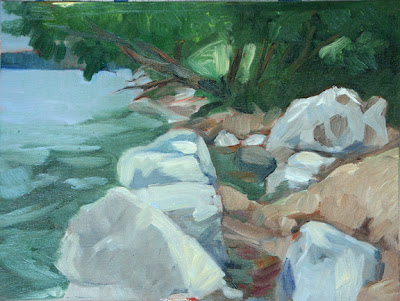People who built on the Lake Ontario flood plain were foolish, but they were also the victims of government planning.
 |
| Flood damage at Six-Mile Creek, Niagara County, NY. |
“We should just bomb the dam,” one disgruntled local told me. We haven’t been at war with Canada in 202 years. Still, this spring Lake Ontario came close to doing what foreign forces haven’t done since 1813: breaching the fortifications at Fort Niagara.
Lake Ontario is bordered by marshy ponds. That’s one indication that its natural levels are highly variable. Long escarpments indicate the limits of a much bigger body of water. When the last ice age ended, this whole area was below sea level. It is still rebounding at a rate of about 12 inches per century. This makes the lakebed gradually tilt southward, creating worse shoreline erosion on the American side than the Canadian.
 |
| Flood damage at Six-Mile Creek, Niagara County, NY. |
But people are short-sighted. None of this has stopped building on the gravel spits that lie between the ponds and the lake itself.
Plan 2014is a new water-regulation plan approved by the Canadian and American government. It went into effect in January, 2017. That, unfortunately, aligned with an unusually soggy spring in the St. Lawrence watershed.
 |
| Flood damage at Six-Mile Creek, Niagara County, NY. |
Terry L. has a modest camp in a trailer park at Six Mile Creek in the town of Youngstown, NY. It may not seem like much, but if you’re a working-class person from Niagara Falls, it’s paradise on a hot summer day. Her family has been summering here for more than sixty years.
 |
| Flood damage at Six-Mile Creek, Niagara County, NY. |
She took me to see it on Sunday. Four of the trailers were gone, moved before they washed away. Several of the others are in water up to their skirting. Decks hang askew over the water, patios are gone. Terry’s dock was thrown up on the ground near her picnic table, which in turn has been buried in a pile of cobblestones more than a foot deep. The beach, so inviting in the summertime, is underwater.
I very rarely see water I don’t want to wade in, but Lake Ontario, in her current cranky, white-capped mood, warned me off.
 |
| Flood damage at Six-Mile Creek, Niagara County, NY. |
Compared to million-dollar houses elsewhere, this trailer park sustained minor damage, but this is not the French Riviera. It will be a struggle for these senior citizens to fix what’s broken.
Niagara County is running a big gas-powered pump to try to lower the pond levels. Since the barrier between lake and pond has been breached, this is a finger in a collapsing dam. Still, municipalities are doing it up and down the lakeshore.
 |
| I thought you told me this would be good for the fish. |
Letting Lake Ontario ebb and flow naturally is a great idea. Naturalists say it will stabilize fish and migratory bird populations. The plan, however, ignores the real-world cost to maintain homes, streets, and water treatment facilities built after the dam was finished in 1958.
I have limited sympathy for those who build pricey homes on flood plains. However, here they’re also the victims of a rule change.
 |
| It continues to rain in the St. Lawrence watershed.. |
The International Joint Commission says that the high water levels have stabilized and should start to recede as the spring rains stop. Meanwhile, as I left Buffalo for points east, it was pouring yet again.




